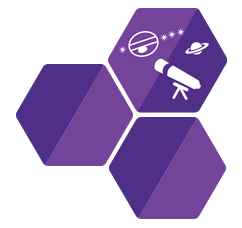Hangouts
 |
The Big Bang We can’t observer how the universe formed, but scientists are still willing to say that we know the universe was created through a Big Bang. In this hangout, you learn the three main lines of evidence for the Big Bang: the universe is expanding, the Cosmic Microwave Radiation, and the mixture of chemical elements. |
 |
 |
Black Body Radiation As children, we’re taught to paint cold things blue and hot things red. In science we learn that blue things are actually far hotter than red things! In this Hangout, we will learn how hot objects radiate energy as light of many colours following what is called a black body curve. |
 |
 |
Electromagnetic Spectrum Today, we are able to study the universe in many colours that can’t be seen with our eyes. From detecting X-rays, to listening to the radio universe, we are able to use digital detectors to “see” hidden aspects of distant objects. In this Hangout, we review the electromagnetic spectrum. |
 |
 |
Gas Laws with Stars and Nebulae Much of the evolution of the universe can be described through the pull of gravity and push of pressure. Gravity condenses gas, it heats up, and if it can, it expands, and if it can’t, stars are formed. In this Hangout, we consider the gas laws, and look at different kinds of nebulae. |
 |
 |
Stars and Energy Transport The Earth is warm because energy created in the core of the Sun is able to travel from the Sun’s Core to its surface, and then shine through space all the way to Earth. As it travels, the light is transformed from deadly high-energy particles to the nice warm light that keeps us alive. In this hangout we discuss the primary ways energy is transported: convection, conduction, and radiation. |
 |
 |
Star (and planet) Formation Our universe started as a fog of particles, but slight variations in density allowed the formation of stars, galaxies, and the large-scale structures of the universe. In this Hangout we discuss early structure formation and fast forward to today’s stars with planets. |
 |
 |
The Four Forces & the Standard Model of Particles Everything in our universe is made up of a very small numbers of particles, and is controlled by just four forces. In this Hangout the expert panel discusses these basic building blocks of everything. |
 |
 |
Chasing Comets [part1] [part2] The solar system is littered with Ice. The bulk of this material orbits quietly in the outer Solar System, but sometimes, something disturbs the ice and the come plunging in toward the Sun. In this Hangout, we discuss comets, how we explore them, and how they brought water to worlds like Earth. |
 |
 |
Charting the Galaxy – from Hipparcos to Gaia Discover the motions of the stars, learn how astronomers measure their distances and look at the European mission that will really get to grips with our place in the Universe. |
|
 |
Planck, Looking Back to the Dawn of Time Take a close look at Planck – a European Space Agency mission built to detect radiation from the microwave portion of the electromagnetic spectrum and how this mission will help find answers to some of the most important questions in modern science. |
|
 |
Exploring the Infrared Universe Investigate the infrared Universe, explore discoveries made by ground-breaking infrared space telescopes, and take a look at Herschel – ESA’s pioneering infrared space telescope. |
|
 |
The Untamed, Violent Universe Have a glimpse of the hot, energetic and often violent Universe revealed through X-ray and gamma-ray astronomy, look at ESA missions that detect this hidden light and find out how the science that these missions perform is meticulously planned. |
|
 |
Following the Redshift – from Hubble Space Telescope to James Webb Space Telescope Identify some of the key discoveries achieved with the famous Hubble Space Telescope, look at the concept of redshift, and meet a new telescope that will be used to uncover the early Universe. |
|
 |
The Sun, Our Local Star Investigate our closest star, the Sun and find out why it is the central engine of the Solar System. Take a look at Ulysses, SOHO and Cluster – the European space missions that have been key to advancing our understanding of the Sun. |
|
